If you’ve ever tried to learn the notes on the guitar fretboard then there’s a good chance you’ve heard a comment like this:
“You don’t find players of ANY other instruments who don’t know the names of the notes they’re playing. It’s ridiculous! If a piano player didn’t know this stuff you’d just laugh at them.”
It may not be the kindest way to put it, but it is true — not knowing what notes you’re playing is practically unheard of when it comes to any other instrument.
Yet, in the world of guitar, it’s very common for people not to know the names of the notes on their neck – even after years or even decades of playing.
To people who don’t play guitar or play other instruments, this state of affairs seems utterly bizarre. “How can you play an instrument and not know what notes you’re playing?”, they think.
There are quite a few angles on this that we could talk about, but today I primarily want to shed some light on the actual task that’s involved in learning the notes on guitar, for those who don’t know.
Since the comparison is so often made with piano players, we’re going to approach this topic by comparing what it is like to learn the notes on guitar vs piano.
Congratulations, pianists…
Piano players, you know it’s true — everyone knows the notes.
You’d really struggle to find any piano player (even an inexperienced hobbyist who only started very recently) who had no idea what the notes are.
But let’s not pat ourselves on the back too hard just yet. Piano players don’t deserve much credit for this, ‘cause here’s the thing:
Learning the notes is REALLY EASY on a keyboard
And I’ll explain why.
The very first thing that strikes you when you see the piano keyboard is how it has white keys and black keys.
The white keys are wider and longer, and the black keys are slimmer and set back from the white keys.
Immediately, the notes are visually differentiated:

Then, when you look slightly closer at the layout of the black keys against the whites, you see that they follow a clear pattern.
The black keys are arranged in sets of 2 and then 3, repeating in that order:

The 2-pair of black keys is always enveloped by 3 white keys, and the 3-pair of black keys is surrounded by 4 white keys.
This is the pattern – it’s the only pattern, and it’s always the same pattern no matter which end of the keyboard you’re on.
The two places where there aren’t black keys are also clearly visible – they’re in-between the white keys at the edges of the pairs of 2 and 3 black keys (this is an important point I will return to in a moment).

The visual nature of the keyboard layout makes learning the notes on the piano a pretty simple process, where not much can go wrong.
Here’s how it works:
The White Keys
On day one of lessons, the teacher simply tells you that these are the names of the white keys, starting from the one just to the left of the two blacks:
C D E F G A B

You play through them a couple of times, and then you’ve got them. C D E F G A B, C D E F G A B, C D E F G A B… Ok. That’s nice and easy.
The Black Keys
What are the black keys called, you might ask? The answer: They’re called the sharps and flats, and they’re named after one of the white keys they’re in-between.
For instance, the black key in between C and D can be called either “C sharp” or “D flat” — meaning one higher than C or one lower than D. Either way, we would be referring to the same note.
So you don’t need to worry about ‘remembering the names of the black keys’, as such, since their names come directly from the white keys.
This means that all you really need to remember is names of the white keys, and then it’s immediately clear what any of the black keys could be called.

The Gaps Between Them
You also can’t forget which keys don’t have a black key between them, because it’s all right there on the keyboard.
Every time you look at your instrument you are automatically reminded of the exceptions.
As soon as you know the names of the white keys you can’t really forget that there’s no note between B-C or between E-F, because there simply aren’t black keys in those positions.
AND... we're done
There are your notes on the piano, and that’s basically all there is to it. This is completely different to guitar, as you’ll see in a moment.
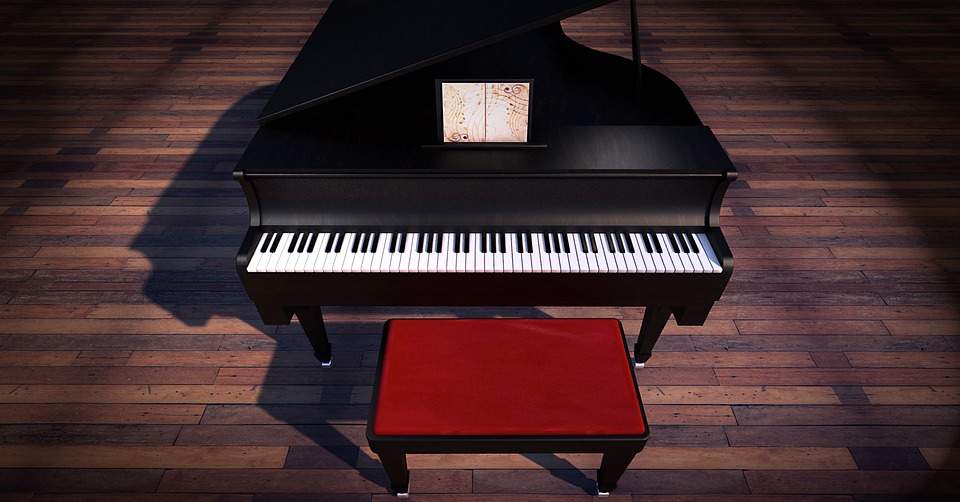
Ok, yes, you haven’t mastered the notes and got them down as well as Chopin on your first lesson. Obviously that kind of mastery only comes with time and experience.
But you do now know the names of all the keys, and you could give the name of any note that someone pointed to within a second or two.
Likewise, if someone asked you to play a specific note you could do it in any octave. Most people who play guitar could not do this.
Whether it takes you a few minutes in your first lesson, or if it takes you a couple of lessons to sink in, the process of learning the notes comes very quickly and naturally on piano.
In contrast, many people who have played guitar for 20+ years couldn’t tell you the name of the note they just played, let alone follow a set of instructions given in notes.
Why is it like this?
Notes on the guitar
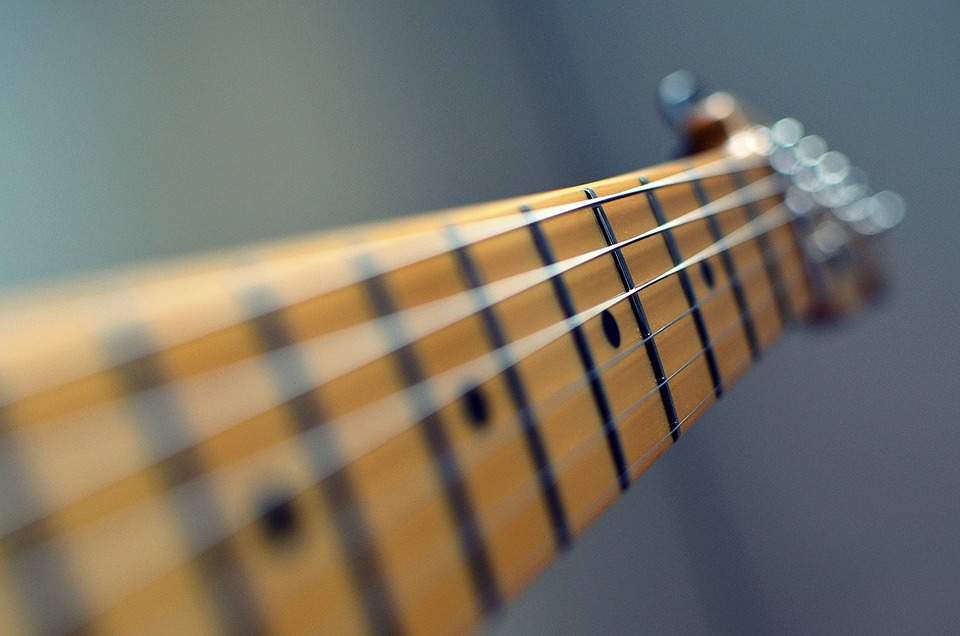
Let’s now compare the task of learning the notes on guitar to what we just saw on piano.
To illustrate how much harder it is, we’re going to treat the guitar neck as if it was a keyboard.
If the guitar were a keyboard...
First, imagine that we take away all the black keys on the keyboard.
All the keys are now equally sized white keys, with nothing to differentiate them from each other other than their absolute position and the occasional dot:

Things aren’t nearly as clear now, are they?
That’s just the beginning of the challenge we have on guitar, because the keys above only account for one string.
We have 6 strings, which each have 21-24 frets. It’s a bit like having six small keyboards on top of each other, like this:
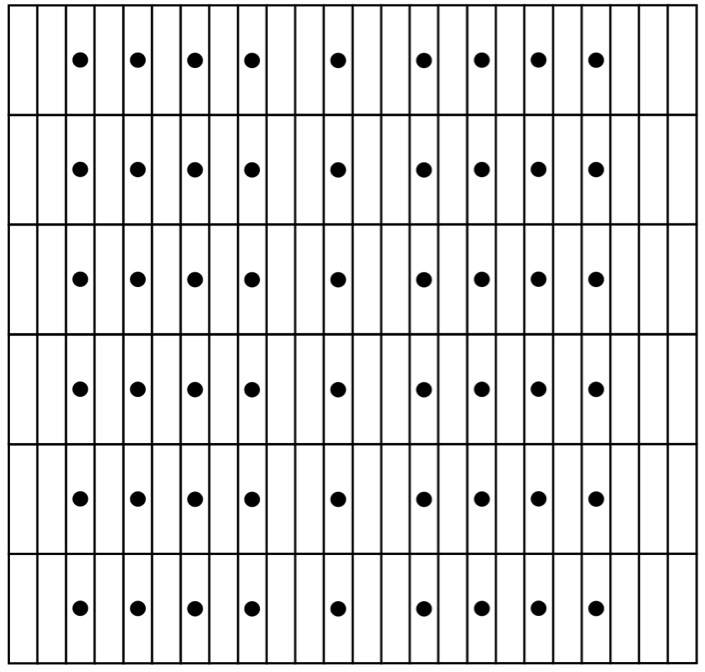
But it’s not even that simple, because our ‘mini keyboards’ aren’t neatly stacked on top of each other.
They’re offset and overlapping, so the pitches of the notes actually start to go like this:
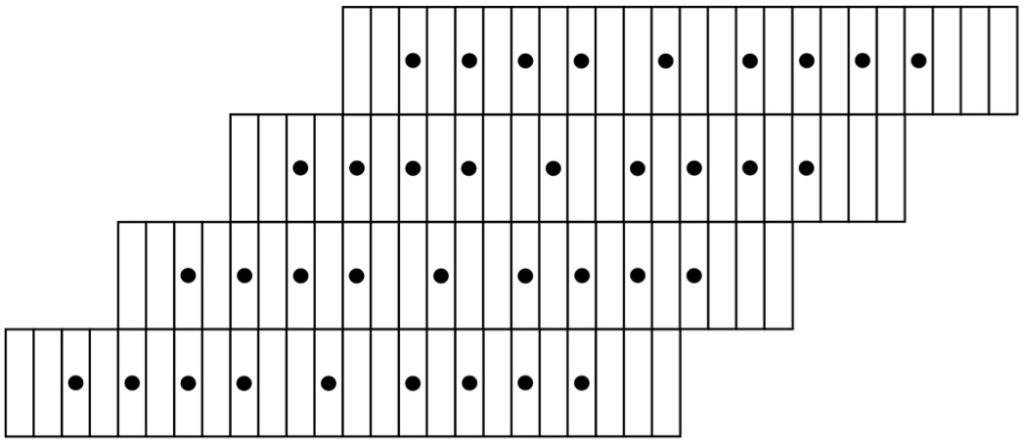
Oh, and we have one final thing — the 5th keyboard from the bottom is a slightly different gap compared to the others, knocking the top two strings 1 fret out of sync with the bottom four.
Really handy, I know:
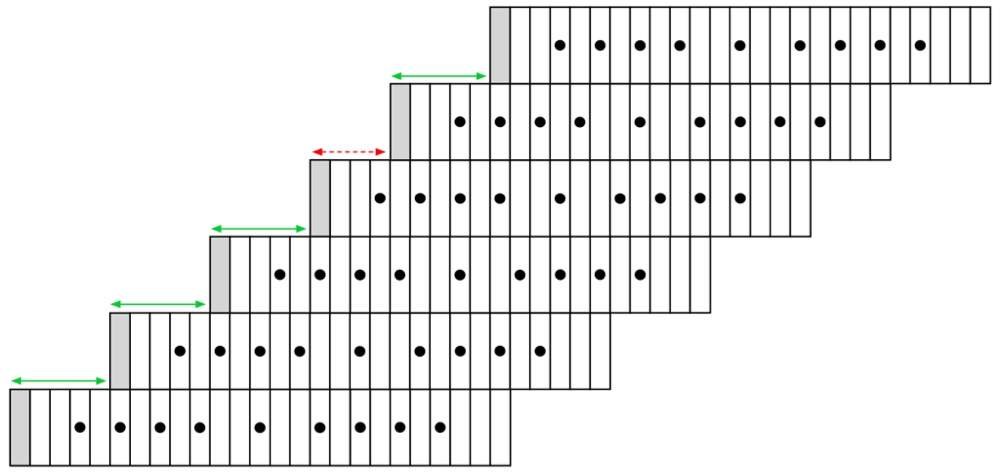
And we’re all set. Good to go.
Sorry, just one final, final thing:
There’s nothing to remind you of the points where there aren’t sharps or flats, and the position of the dots has nothing to do with the notes (just in case you were starting to think there was some kind of link – there isn’t).
Now memorise the position of every note on the guitar.
What’s the hold up? Let’s go!
Maybe now you can understand a little better why this is a challenge and “a thing” for guitar players.
That’s the deal
To say it’s harder to learn the notes on guitar than on piano would be a huge understatement, to put it mildly. It’s a completely different thing entirely.
Indeed, we know learning the notes on guitar is “a thing” in the first place, isn’t it? That’s why we’re here talking about it.
It’s “a thing” precisely because the difficulty of the task is so much greater than it is on other instruments, like piano.
Recalling the comment that started this article:
“If a piano player didn’t know this stuff you’d just laugh at them!”
Well, some people might, but that would only be because they know that learning the notes on piano is easy and doesn’t require any real effort, to be similarly blunt.
Once you’ve absorbed basically the first lesson on the names of the white keys, you only need to look down at your instrument and you’ll know which note is which based on its position within the pattern.
You don’t need to expend any effort or strain yourself to see the notes in their pattern. It’s all right there. You just learn them, pretty much from your first lesson, and your facility with them only gets faster and more fluid from there.
Guitarists aren’t stupid
If you have struggled with learning the guitar fretboard in the past, then take heart.
We can use euphemisms and say “it’s challenging”, or we can just call the task of memorising the fretboard what it is — hard.
It’s not “challenging”, like solving a puzzle is challenging. It’s just “hard”, more like carrying a sack through the rain. Carrying the sack is not complicated, but it does take consistent effort and a motivation or desire to reach the goal or finish line.
There is no point in coming into the task not appreciating this.
People who are used to grasping things without having to put in any effort will find that just doesn’t work here. Maybe you have lacked results in the past because you didn’t give it enough energy and input, not because you lack the ability to do it.
It does take some work to learn the fretboard. It requires a deliberate effort, and it requires consistency.
The guitar neck is essentially a great big grid where every note looks basically the same as the last, and you need to deliberately drill the note names in with brute force to make them stick.
The notes on guitar are not something you acquire passively or get for free like you do learning some instruments. If you think it’s something that just comes by itself, it definitely doesn’t and won’t.
Like I said, I don’t think guitar players are stupid, but I also know there’s more to this than the simple fact that learning the notes on guitar requires more effort than other instruments.
It’s harder – yes – but it’s still totally achievable for any player. Yet the majority of players never do it. Why?
Guitar players aren’t stupid…
But some of their attitudes definitely are…
I’ve defended guitar players so far, because I know from playing both instruments that it’s a lot more work to learn the notes fluently on the guitar than it is on keyboard.
However, something I don’t defend is the negative and suspicious attitude towards musical knowledge which a lot of guitar players harbour.
At the start of this article, I said that people are quite right when they say that it’s unheard of for a player of any other instrument not to know the notes they’re playing.
You know what else is unheard of anywhere else in the world of music? Dumbass questions like this:
“Why should I learn the notes on my instrument?”
I’m only going to address this briefly today, as it would require another article to get into in depth. However, I can’t write anything about learning the fretboard and not at least touch on this problem.
Knowing what I know and not talking about this would be like ignoring an elephant in the room; an elephant blasting Slayer at full volume.
I know people love to say there’s “no such thing as a stupid question” but that’s simply not true, and this is a perfect case in point.
If you play an instrument and you want to be as good as you can be, then asking this is like a would-be mechanic asking “Why do I need to understand how an engine works?”, or a medical student asking a surgeon “What’s the point of me learning anatomy?”, or a trainee accountant asking “Why would I want to be good at arithmetic?”…
…
You’re literally asking why you should know something that is an inseparable part of what you claim to want to do.
What was that you were saying a second ago about there being no such thing as stupid questions?
Asking how or why it would benefit you – as an aspiring musician – to learn the names of the notes when all the music in the world is made from notes?
Seriously, come on. To borrow a famous phrase from a certain tennis player, you cannot be serious!
In addition to making absolutely no sense, It’s clear when a “question” is really a distraction or attempt to start a debate, rather than a sincere question motivated by the desire to understand.
I’ve been teaching the guitar for well over 10 years, and I can tell you this:
There’s a very big difference between the sound of genuine confusion, and the sound of someone who has played for far too long not to know the first thing about their instrument being defensive, blowing hot air, BS-ing, procrastinating, and grasping for excuses not to sort out something they know they should.
Guitar is the only instrument where you find aspiring musicians who studiously avoid learning anything about music!
Would it help if I told you it’s always the number 1 regret of great players who learned to play by ear, that they never learned the notes?
I learned this lesson from my uncle, whose blues-rock playing I was in awe of when I was young. He was a fantastic player but he didn’t know what he was doing, and he told me it was his biggest regret and frustration about playing.
I have heard exactly the same sentiment expressed many times in different words by many other guitarists whom I respect greatly:
I don’t know [music] theory and it’s frustrated me all my playing life. [It’s] been a hindrance to expanding my playing or evolving because I’m not sure how all the pieces are supposed to fit together.
George Lynch in interview with MusicRadar
People who try to argue this always – always, without fail – mention Jimi Hendrix at this point, as though merely uttering his name justifies not learning anything about music.
If you’re one of these guys who cries “But Jimi Hendrix didn’t…”, as if mentioning a single musician who died in 1970 at the age of 27 is a valid reason for not knowing anything in 2019, you might want to stop trading in myths and do some research to find out what the big man himself actually thought about getting educated:
“I'd like to take a six-month break and go to a school of music. I want to learn to read music, be a model student and study and think. I'm tired of trying to write stuff down and finding I can't. I want a big band. I don't mean three harps and 14 violins – I mean a big band full of competent musicians that I can conduct and write for.”
Jimi Hendrix in "Starting at Zero: His Own Story"
We could (- and we will) talk about the “but Jimi” excuse in a whole other article on another day. (PS If you’d like to see a glimpse of the kind of the things he actually knew, you can check out my article on The Hendrix Chord).
For now, it suffices to say that people are operating on hearsay that has been passed around and distorted in the manner of chinese whispers, and they truly have no idea what they’re talking about when it comes to what famous players did or did not know.
The notes on the fretboard do require some work to learn – yes – and that aspect will inevitably put some people off, which is sadly their loss.
I get that not everyone cares how things work or will make the effort to learn, but I struggle to understand how you could fail to see “why” it would be a good thing to know the notes you’re playing.
“Hey, I’m here to learn, but I have a question:
Why do I need to learn? I don’t get it.”
That’s what I hear here — not a real question, but a pointless distraction and exercise in time-wasting.
It’s the verbal equivalent of the stuff that jet planes fire out the back to distract the homing missile in movies, only there’s nothing to avoid.
Is this ANTI-KNOWLEDGE attitude a big part of the reason why so many guitarists don’t know what notes they’re playing?
Absolutely 100% yes.
Is it possible that RESISTING KNOWLEDGE and NOT UNDERSTANDING HOW YOUR INSTRUMENT WORKS will prevent you from progressing very far?
Now that sounds like another pretty stupid question right there, doesn’t it?
This article is not here to convince you to learn the names of the notes on your instrument (though you should), nor to point out all the benefits that will flow from knowing what you’re doing (though they are many), but simply to demonstrate what’s involved.
Now, with all that said:
What is the best way to learn the notes on guitar?
I’ve seen and taught multiple methods to learn the fretboard over the years, and I’ve noticed something very interesting.
Some methods were quite dry and could be a bit boring, others were more practical, varied and more fun, some were more thorough than others, and one or two stood out above the rest.
All the methods involve doing exercises or drills of some kind to embed the note names into the fretboard. There is no magic method that I have ever seen that shortcuts this.
The better methods definitely make learning faster, more fun, and ultimately make the knowledge more useful and useable, but what I noticed is that almost any of them would work. If…
… If you really want to learn it.
Because the biggest factor involved is the person learning it. You.
So, whatever your exact method, I really believe that the foundation of success here is 99% to do with how you think about it.
The main thing it comes down to is your own desire to learn the fretboard. If this is strong, then your actions will roughly follow in line and you’ll do something about it.
If you believe the prize will be highly valuable (which it is) and you really want to crack it, then you will find the motivation to practice it and you will learn it one way or another.
Whichever method you use, here are some tips for getting results:
- Accept it as a project - as we’ve said; acknowledge that it’s a bit of “a thing”, it’s a problem you’re going to solve, and it will feel great when you finally crack it
- Accept that the final ideal you imagine of knowing your fretboard inside out won’t come about immediately
- Accept that certain exercises may not be the absolute most “exciting” item on your practice routine. If this bothers you then take a few minutes to do your fretboard exercises first, before moving onto more fun things like practicing songs.
- When practicing, shift your focus to “am I enjoying this?” to “I am becoming a better player”. Being good is fun, so doing the things that will make you good is going to enable you to have more fun. That’s the right way to think about it.
- Practice it consistently and build momentum, because this is something that definitely needs lots of repetition. Nobody is exempt from the work required.
- It's not all or nothing. Notice and appreciate that things are getting steadily better along your journey. Things may not be complete yet, but you’re getting better and understanding more every day. Every improvement, even if its small, is better than before, and potentially opens up new doors.
- Believe that the process is worth it (it is), and that the payback will be 100 times the relatively small amount of effort and practice you need to put in now
- Keep picturing how fantastic it will feel when you finally know your fretboard, and all the amazing things you’ll be able to do, no longer hindered by confusion and ignorance. Picture and hear yourself enjoying your new skills, because soon they will be yours.
- Picture all the people who look down on guitarists… and think of how good it will be once you can finally feel like a real musician, playing the coolest instrument in the world.
Whatever you do, don’t forget to do THIS
Here’s my final tip for today.
On guitar, not only do we need to deliberately and actively drum the notes into the fretboard, you also need to actively start making yourself see things ever more in terms of notes.
The worst thing that people always do is that they go out and do a bunch of drills and start learning the board quite well in an “exercise-y” kind of way.
It’s not the drills or exercises that are at fault. It’s what they do (or more accurately, don’t do), next.
Outside of their specifically designated “fretboard practice”, they just continue looking at their playing as if they still don’t know the notes, i.e. calling notes 7-5-4 etc, like they’re tabs.
To prevent this happening, as you start to learn the notes and get them down you need to actively start making the connection between the note names and the frets you’re playing in real life.
You don’t need to go overboard and stress yourself out working out the notes of every single thing immediately, but as you incorporate more of this into all aspects of your playing that’s when you will really start to ‘know the fretboard’.
This is the critical step that most people don’t think to take, and it means that they’re always stuck on the previous level, with the new information never really ‘taking hold’ and becoming familiar.
And there you have it. Now you understand a couple of the biggest reasons why not knowing the notes in so common in the guitar world. If you are currently trying to learn your fretboard, now I hope you can appreciate more clearly what it is you’re trying to do.
Perhaps realising this will mean that you can be more patient with yourself and give it the time it deserves when you are practicing it. Whether that time is now, or if you return to it in future, I hope this article helps you get your thinking on track.
Rock on, friends and fellow guitarists…
… and learn the notes on the f***ing fretboard! You’re making us all look bad in front of the piano players 😉
– Christy